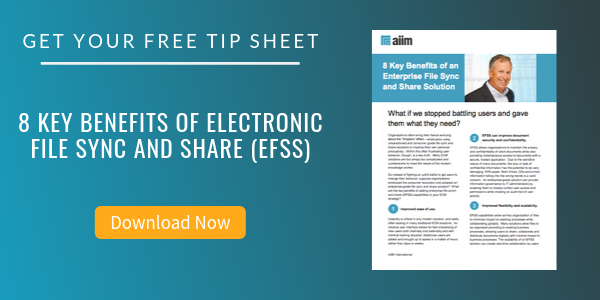
What If We Stopped Battling Users and Gave Them What They Need? – EFSS
Enterprise File Sync and Share (EFSS)
Organizations often wring their hands, worrying about the “Dropbox” effect – employees using unsanctioned and consumer-grade file sync and share solutions to improve their own personal productivity. Within this often frustrating user behavior, though, is a key truth: Many ECM solutions are too simply too complicated and cumbersome to meet the needs of the modern knowledge worker.
So instead of fighting an uphill battle to get users to change their behavior, suppose organizations embraced the consumer revolution and adopted an enterprise-grade file sync and share solution? What are the key benefits of adding enterprise file synch and share (EFSS) capabilities to your ECM strategy?
1. Improved ease of use.
Usability is critical in any modern solution, and sadly often lacking in many traditional ECM solutions. An intuitive user interface allows for fast onboarding of new users both internally and externally and with minimal training required. Additional users are added and brought up to speed in a matter of hours rather than days or weeks.
2. EFSS can improve document security and confidentiality.
EFSS allows organizations to maintain the privacy and confidentiality of client documents while also providing instantaneous access to documents with a secure, hosted application. Due to the sensitive nature of many documents, the loss or leak of confidential information has the potential to be very damaging. With paper, flash drives, CDs and e-mail, information falling into the wrong hands is a valid concern. Anenterprise-gradesolutioncanprovide information governance to IT administrators by enabling them to closely control user access and permissions while creating an audit trail of user activity.
3. Improved flexibility and scalability.
EFSS capabilities allow ad-hoc organization of files to minimize impact on existing processes while collaborating globally. Many solutions allow files to be organized according to existing business processes, allowing users to share, collaborate and distribute documents digitally with minimal impact to business processes. The scalability of an EFSS solution can create real-time collaboration by users across the world over large and complex collections of documents.
4. EFSS can speed up many core back-end processes.
One place EFSS can make a big difference is in a department that is often skeptical of cloud-based solutions, finance. Consider the audit process. Many methods – from paper shipments to CDs, e- mail and electronic file transfer – exist to provide auditors with the information they request. However, physically shipping paper files, or even CDs, is costly and time consuming. Electronic file transfer solutions are equally arduous due to the volume of files required and connection instability. All of these distribution methods required individual files to be sent to individual auditors. And when more than one auditor requests the same file, collaboration is often impossible.
5. Paper documents are easily lost or damaged.
Historically, governing paper files and documents is difficult because paper is too easily damaged or misplaced. This is particularly true in situations where users – whether staff or external authorized users -- must review information on-the-go and in a wide variety of work environments.
6. Anytime access eliminates costly travel and expenses.
Eliminating the need to duplicate files and Fedexing them from location to location is often cost- justification for even a fairly complex EFSS solution. Everything is available instantaneously, providing information anytime, anywhere.
7. Audit trails confirm secure and authorized access.
The audit trails in an enterprise-scale solution provide complete visibility into document access. Every modification made to the files is recorded, and changes can only be made by users with authorized access.
Safe and secure file sharing and storage.
Files are stored in one location and shared automatically by the system rather than e-mail. Only those who should have access to certain documents have access, using individually-granted permissions.
Conclusion
To respond to current customers, create new business opportunities and maintain an overall competitive advantage, organizations need secure, timely, and accurate access to key information. This requires a holistic approach to information and content management – developing and supporting an information ecosystem that offers an infrastructure for sharing, collaborating, and analyzing content in ways that enhance its value and maximize its use.
One way to achieve these objectives is by extending applications – such as an enterprise content management (ECM) solution – by leveraging file sync and share tools. An effective cloud-based sharing approach can help bridge content silos across the enterprise, providing consistency in content, enhancing internal and external collaboration, and improving access.
About John Mancini
John Mancini is the President of Content Results, LLC and the Past President of AIIM. He is a well-known author, speaker, and advisor on information management, digital transformation and intelligent automation. John is a frequent keynote speaker and author of more than 30 eBooks on a variety of topics. He can be found on Twitter, LinkedIn and Facebook as jmancini77. Recent keynote topics include: The Stairway to Digital Transformation Navigating Disruptive Waters — 4 Things You Need to Know to Build Your Digital Transformation Strategy Getting Ahead of the Digital Transformation Curve Viewing Information Management Through a New Lens Digital Disruption: 6 Strategies to Avoid Being “Blockbustered” Specialties: Keynote speaker and writer on AI, RPA, intelligent Information Management, Intelligent Automation and Digital Transformation. Consensus-building with Boards to create strategic focus, action, and accountability. Extensive public speaking and public relations work Conversant and experienced in major technology issues and trends. Expert on inbound and content marketing, particularly in an association environment and on the Hubspot platform. John is a Phi Beta Kappa graduate of the College of William and Mary, and holds an M.A. in Public Policy from the Woodrow Wilson School at Princeton University.



